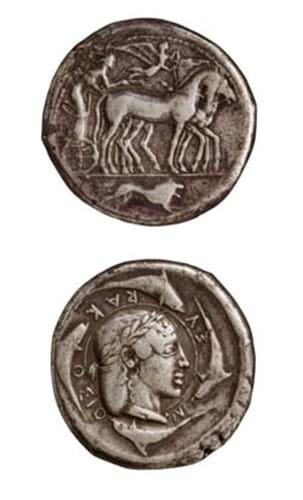
The multi-million pound Prospero collection contains over 600 coins from the Archaic, Classical and Hellenistic Greek periods and includes some of the rarest and most historically important examples of Greek coinage.
The collection, formed over several decades, has remained untouched since being completed 20 years ago. Baldwin's ancient coin specialist Paul Hill said: "The Prospero collection is the most important collection of ancient Greek coins to appear on the market… since the sale of the Nelson Bunker Hunt collection in New York."
He also explained why the anonymous collector had named the collection Prospero: "Like the character of Prospero in Shakespeare's The Tempest, an underlying preoccupation for the magical and mythical can be seen throughout the collection."
It ranges from the sixth to third centuries BC and contains, among other highlights, coins from ancient Sicily, including hugely sought-after examples of the die-engraver's art from Syracuse.
Baldwin's have singled out a number of star lots to give a taste of the breadth and depth of the collection. Among them are examples of the dekadrachm of Syracuse, one of the largest and most famous of all ancient Greek coins, including a signed example, struck from the very first pair of dies engraved by the artist Kimon.
The famous Demareteion dekadrachm, considered to be one of the most beautiful creations of fifth century BC numismatic art, is also represented. The artist who created this coin is considered to be one of the greatest master engravers of the Archaic and Classical periods.
"Supreme artistic beauty matches exceptional rarity throughout the collection and none represents this more than the breathtaking gold stater from Pantikapaion, the importance of which cannot be exaggerated," said Mr Hill. "It bears a facing head of a satyr, bearded and with long dishevelled hair. The work of a master artist, it is without doubt the greatest ancient Greek gold coin."
He added: "The catalogue for the Prospero collection is still being prepared, however Baldwin's anticipate that the Naxos tetradrachm will be estimated in the region of £60,000-£80,000, and the Demareteion dekadrachm in the region of £80,000-£100,000."
There are a number of examples of the coinage of the city state of Naxos. One such is the tetradrachm from the mid fifth century BC, its obverse type depicting the head of Dionysos and its reverse showing Silenos with his drinking cup. "Perhaps another of the greatest of all fifth century ancient Greek coins," says Mr Hill, it is important as it illustrates a move from the more rigid Archaic artistic style to a more naturalistic Classical one. The master-engraver who produced the dies for this coin is believed to be the same individual known as the 'Aitna Master', who produced the famous, and unique, tetradrachm of Aitna.
ATG coins correspondent Richard Falkiner has confirmed the importance of the Demareteion dekadrachm, pinpointing it as the example that took $90,000 in the Bunker Hunt sale at Sotheby's New York on June 19, 1990, selling again at Bank Leu in Switzerland on May 15, 1991 for SFr132,500, then about £53,000.
The collection, will be offered as part of Baldwin's 140th anniversary celebrations, on January 4 at the Waldorf Astoria hotel, New York as part of The New York Sale XXVII-XXVIII.
Meanwhile, Morton & Eden are also working on a major collection of ancient Greek coins for their October 24 sale.
The 168-piece collection has been put together over the past 50 years and covers high quality examples mainly of the archaic and classical periods (6th to 4th centuries BC).
Expectations run to £1.5m in total.
Further details have yet to emerge as cataloguing is still underway, but the selection in this image, examples include 5th and 4th century tetradrachms of Barce in Cyrenaica, Rhodes; similar aged tetradrachms of Leontini and Naxos in Sicily; a triple siglos of Kos; and Cretan staters of Phaistos and Gortyna.
By Ivan Macquisten




